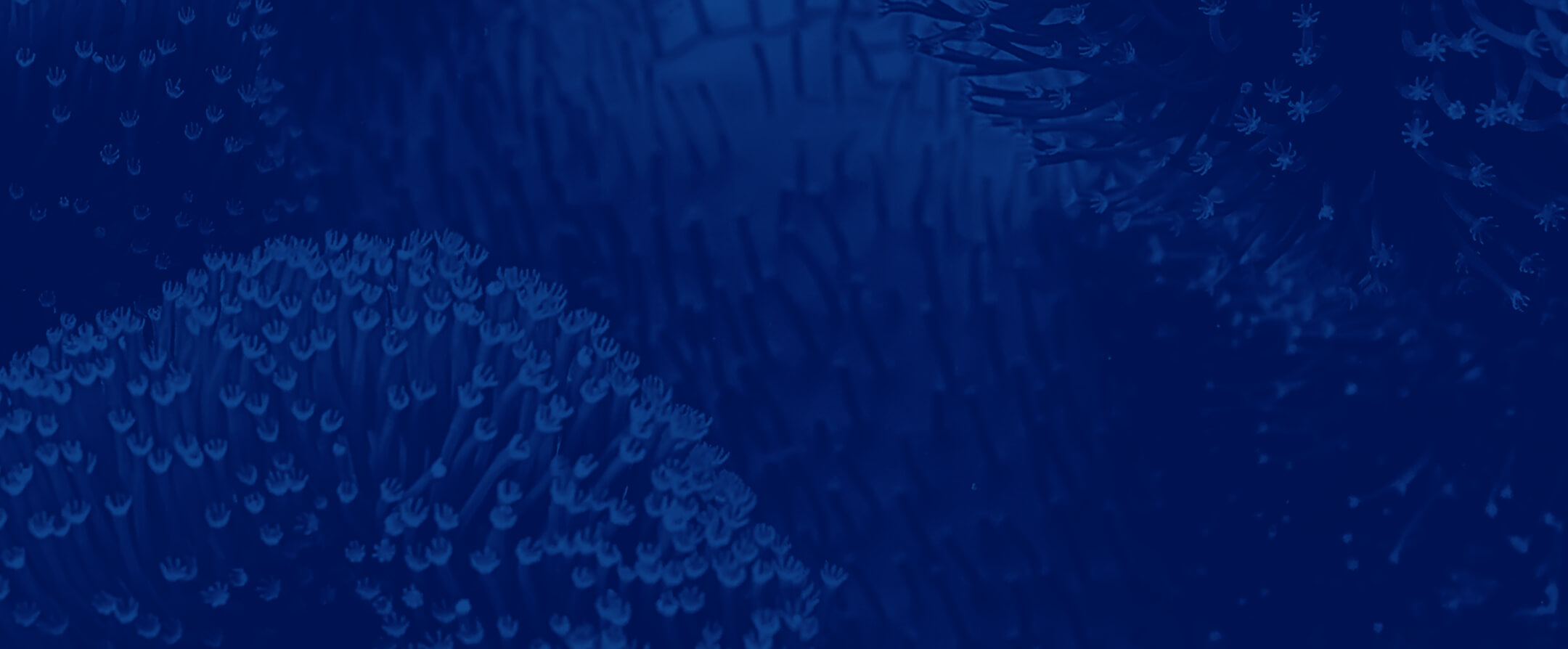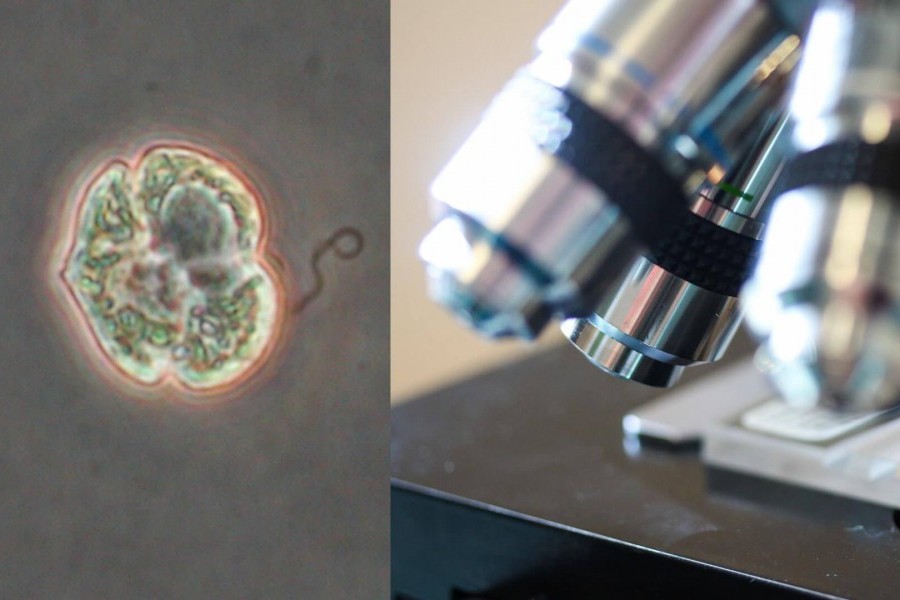Just like other community members, many marine scientists were self-isolating to protect public health in April 2020. In the meantime, researchers from multiple institutions were joining forces—mostly virtually, for now—to arrange the next major steps in a quest to fight impacts of Florida red tide, through new competitive grants from the Florida Red Tide Mitigation and Technology Development Initiative.
The Initiative—led by Mote Marine Laboratory in partnership with the Florida Fish and Wildlife Conservation Commission (FWC)—was established and supported by state appropriations in June 2019. It focuses on uniting the best and brightest scientists from around the world in game-changing efforts to reduce impacts of Florida red tides, blooms of the toxin-producing algae species Karenia brevis. (Initiative details: www.redtidemtdi.org)
Mote’s President & CEO, Dr. Michael P. Crosby, said: “Understandably, Florida red tide is not the first thing on most people’s minds today, as we face the unfolding emergency of the COVID-19 pandemic. Our highest priority is to support each other and protect public health during this crisis, and we sincerely thank the frontline responders for their vital, tireless efforts. At the same time, extensive research and centuries of history tell us that Florida red tide will return, and we have not forgotten how drastically it affects our health, economies, ecosystems and quality of life. COVID-19 has not stopped the progress of this important initiative. Our scientists are dedicated to red tide mitigation and technology development because we believe that reducing the stress of these harmful algal blooms will leave our communities stronger and more prepared to respond to each new red tide challenge we face together.”
Through the Florida Red Tide Mitigation and Technology Development Initiative, Mote scientists are already testing multiple compounds and methods for their potential to destroy, remove or otherwise reduce the impacts of Florida red tides and their brevetoxins—which kill fish and other marine life and cause respiratory irritation in beachgoers—while also expanding research infrastructure to quickly and safely test compounds in controlled settings and advance technologies for red tide detection to support mitigation.
In November 2019, at the U.S. Harmful Algal Bloom Symposium, Mote announced the first of six annual, competitive grant opportunities open to top scientists, engineers and innovators from around Florida, the U.S. and the world. In early 2020 a panel of Ph.D. scientists from eight different agencies and institutions reviewed the 20 grant proposals submitted, and the strongest five proposals were presented to the Red Tide Initiative Technical Advisory Council by partnering scientists representing institutions from across the U.S. east coast. Those five projects have now been subcontracted by Mote to begin their work as soon as possible.
“We prioritized projects that would bring novel ideas to the table or expand testing of previously researched products and technologies that can assist resource managers with red tide mitigation immediately or in the very near future,” Crosby said. “We encouraged applicants to leverage the advanced research infrastructure that Mote is developing and expanding through the Initiative and take advantage of the opportunity to partner with Mote and FWC scientists who continue to advance in their longstanding, fruitful collaboration in Florida red tide research and monitoring.”
- Mote will launch the year-2 request for proposals (RFP) at www.redtidemtdi.org on May 1 (closing June 30) and host a webinar on the RFP on May 15. Check www.redtidemtdi.org for the webinar link and teleconference information.
Five partner projects were selected for year 1 and awarded about $1,020,000 combined total grant support. Of course, projects will adapt their strategies to accommodate all public health measures related to COVID-19.
Year-1 partner projects:
- Optimizing production of a dinoflagellate–specific algicide for control of Karenia brevis
Principal investigator: Dr. Kathryn J. Coyne (University of Delaware, UD)
Co-principal investigators: Dr. Vincent Lovko and Dr. Dana Wetzel (Mote Marine Laboratory)
Project summary: Researchers already know that certain bacteria naturally produce compounds that are “algicidal”—lethal to at least some species of algae. This project focuses on optimizing production of algicide by certain bacteria for use on the Florida red tide alga, Karenia brevis, identifying which bacteria-produced compounds are the most algicidal to K. brevis and evaluating the potential risks of applying the algicide, starting experiments with K. brevis algae cultured in the lab and then validating those results with natural communities of microscopic algae.“This project will allow us to fine-tune production of a bacterial algicide to specifically target blooms of Karenia brevis,” said Dr. Kathryn J. Coyne of University of Delaware. “Although we have gathered a lot of data about the effects of this algicide on other species, this will be the first opportunity we have to optimize its production for a single species.”
- Pushing Karenia over the edge with beer derived flavonoids
Principal investigator: Dr. Allen Place (University of Maryland Center for Environmental Science—Institute of Marine and Environmental Technology, UMCES—IMET)
Co-principal investigators: Taylor Armstrong (UMCES—IMET), Dr. Vince Lovko and Dr. Richard Pierce (Mote Marine Laboratory)
Project summary: This project will test natural compounds from “brewer’s spent grain” (BSG)—a readily available byproduct of beer breweries—for their potential to fight K. brevis and degrade its brevetoxins. Scientists know that a related product, barley straw, produces compounds that can fight certain algal blooms as the straw decomposes over time. However, the slow release of compounds is not practical for K. brevis blooms that form in ocean waters offshore because it must be deployed well ahead of algal-bloom formation and remain near the bloom. Also, it is not clear that the barley straw would degrade or produce the same compounds in saltwater that it does in freshwater. In contrast, BSG has five times greater concentrations of certain barley compounds—phenolic acids and flavonoids—that can fight algae in the lab, and BSG is already releasing these compounds when it leaves the brewery, so project partners aim to assess its practical use for controlling K. brevis and its toxins. - A thin shroud with integrated algaecide to flocculate and sink Karenia brevis
Principal investigator: Dr. Vijay John (Tulane University)
Co-principal investigator: Tim Mclean (Tulane University)
Project summary: Project scientists aim to test an advanced technology designed to “smother” K. brevis, pull it to the bottom and treat it with algaecide in a targeted, controlled way. The technology is a super thin, environmentally benign shroud called a “metal phenolic network” that will be combined with clay particles to weigh down the shroud, and uniquely, will carry natural clay nanotubes with algaecide inside. This year-1 project focuses on testing the technology in the lab and in larger-scale “mesocosm” systems in collaboration with Mote, to understand its effectiveness, logistical and cost requirements, and potential side effects, such as release of toxins from dying K. brevis cells. If the project is successful in its first year, project leaders aim to transition to field experiments with Mote and FWC.“The project represents technology that has the potential to ameliorate the red tide without causing damage to other organisms in the ecosystem,” said Dr. Vijay John of Tulane University. “The work will tremendously benefit from the technical expertise and resources at Mote Marine Laboratory.”
- Fate and effects of Karenia brevis cells, toxins, and nutrients following clay application for bloom control
Principal investigator: Dr. Don Anderson, Woods Hole Oceanographic Institution
Co-principal investigators: Dr. Richard Pierce, Jim Culter, Dr. Emily Hall and Dr. Vince Lovko (Mote Marine Laboratory) and Dr. Kristy A. Lewis (University of Central Florida-National Center for Integrated Coastal Research)
Project summary: Laboratory studies suggest that kaolinite clay particles can “grab,” sink, and destroy K. brevis algae, helping remove K. brevis cells and their toxins from water. Clays have been used to treat other algal blooms for more than 20 years in South Korea and China, often covering areas as large as 40 square miles, but further research is needed to transition clays for use in the U.S. This new project will advance ongoing research of kaolinite clay as an effective and ecologically sound method for mitigating and decreasing the impacts of Florida red tide. The team will use large experimental systems called mesocosms to further investigate how clay affects K. brevis and organisms from Gulf of Mexico environments. For example, when the clay pulls K. brevis to the bottom, do its toxins harm bottom-dwelling marine organisms more than they would without the clay? Does the clay capture or release nutrients? What are the best locations and procedures for applying clay? These and other questions must be addressed to apply clays to Florida red tide.“This project is critical to ongoing efforts to bring the most globally advanced, scalable, and widely used red tide control strategy to Florida and the U.S.,” said Dr. Don Anderson of Woods Hole Oceanographic Institution. “To accomplish this goal, we need controlled experiments that match natural environmental conditions as closely as possible, and that is best accomplished with the scientific staff and mesocosm facilities at Mote, supported by Red Tide Initiative funding.”
- Examining the feasibility of removing and composting fish carcasses to mitigate red tide
Principal investigator: Dr. Michael Parsons (Florida Gulf Coast University)
Co-principal investigator: Dr. Cynthia Heil (Mote Marine Laboratory)
Project summary: Florida red tide can cause large-scale fish kills—a major impact to coastal ecosystems and communities’ quality of life—and decomposing fish release nutrients that K. brevis can use, possibly causing a positive feedback loop that could worsen red tide. This process should be better quantified (represented in terms of numbers/quantities) to understand its significance. This project aims to: better quantify the nutrient inputs to Florida red tide from fish kills in southwest Florida; conduct a cost/benefit analysis of removing dead fish to help mitigate red tide; and evaluate composting these fish (using a compost-accelerator compound) to produce fertilizer for local stakeholders.“We know decomposing fish release nutrients that support red tide,” said Dr. Michael Parsons of Florida Gulf Coast University. “If the fish are a major source of nutrients, and it’s economically feasible to remove them, we may be able to reduce red tides.”


